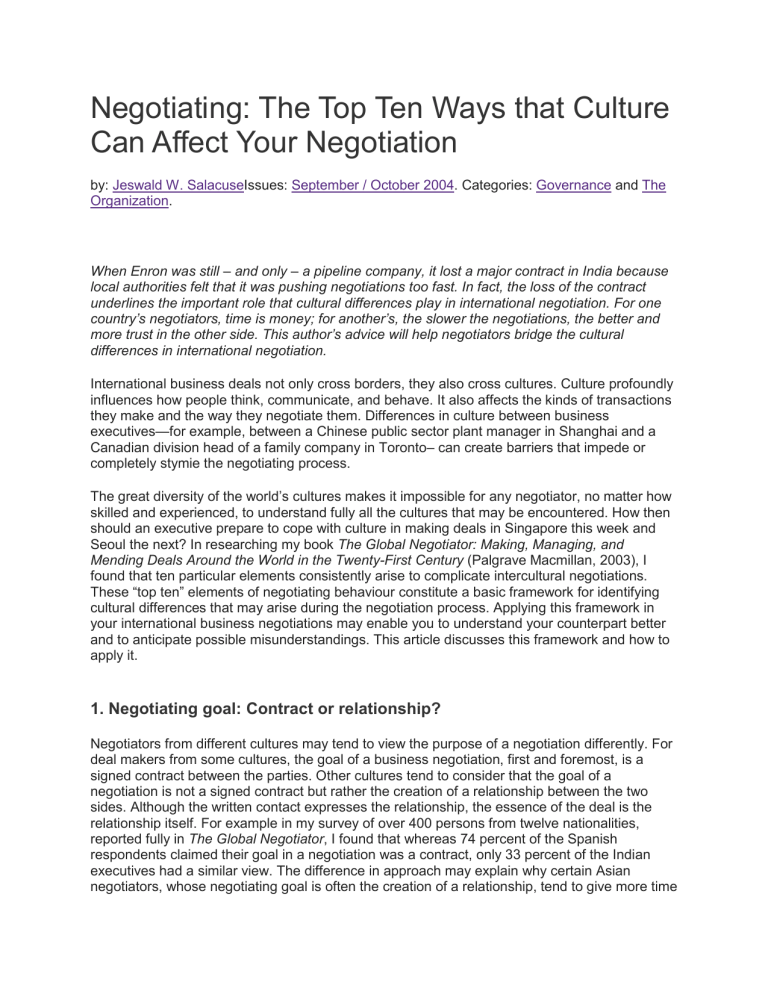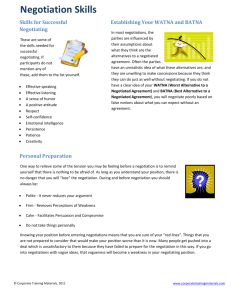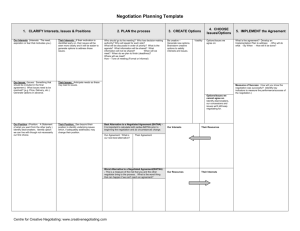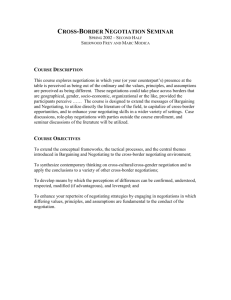
Negotiating: The Top Ten Ways that Culture Can Affect Your Negotiation by: Jeswald W. SalacuseIssues: September / October 2004. Categories: Governance and The Organization. When Enron was still – and only – a pipeline company, it lost a major contract in India because local authorities felt that it was pushing negotiations too fast. In fact, the loss of the contract underlines the important role that cultural differences play in international negotiation. For one country’s negotiators, time is money; for another’s, the slower the negotiations, the better and more trust in the other side. This author’s advice will help negotiators bridge the cultural differences in international negotiation. International business deals not only cross borders, they also cross cultures. Culture profoundly influences how people think, communicate, and behave. It also affects the kinds of transactions they make and the way they negotiate them. Differences in culture between business executives—for example, between a Chinese public sector plant manager in Shanghai and a Canadian division head of a family company in Toronto– can create barriers that impede or completely stymie the negotiating process. The great diversity of the world’s cultures makes it impossible for any negotiator, no matter how skilled and experienced, to understand fully all the cultures that may be encountered. How then should an executive prepare to cope with culture in making deals in Singapore this week and Seoul the next? In researching my book The Global Negotiator: Making, Managing, and Mending Deals Around the World in the Twenty-First Century (Palgrave Macmillan, 2003), I found that ten particular elements consistently arise to complicate intercultural negotiations. These “top ten” elements of negotiating behaviour constitute a basic framework for identifying cultural differences that may arise during the negotiation process. Applying this framework in your international business negotiations may enable you to understand your counterpart better and to anticipate possible misunderstandings. This article discusses this framework and how to apply it. 1. Negotiating goal: Contract or relationship? Negotiators from different cultures may tend to view the purpose of a negotiation differently. For deal makers from some cultures, the goal of a business negotiation, first and foremost, is a signed contract between the parties. Other cultures tend to consider that the goal of a negotiation is not a signed contract but rather the creation of a relationship between the two sides. Although the written contact expresses the relationship, the essence of the deal is the relationship itself. For example in my survey of over 400 persons from twelve nationalities, reported fully in The Global Negotiator, I found that whereas 74 percent of the Spanish respondents claimed their goal in a negotiation was a contract, only 33 percent of the Indian executives had a similar view. The difference in approach may explain why certain Asian negotiators, whose negotiating goal is often the creation of a relationship, tend to give more time and effort to negotiation preliminaries, while North Americans often want to rush through this first phase of deal making. The preliminaries of negotiation, in which the parties seek to get to know one another thoroughly, are a crucial foundation for a good business relationship. They may seem less important when the goal is merely a contract. It is therefore important to determine how your counterparts view the purpose of your negotiation. If relationship negotiators sit on the other side of the table, merely convincing them of your ability to deliver on a low-cost contract may not be enough to land you the deal. You may also have to persuade them, from the very first meeting, that your two organizations have the potential to build a rewarding relationship over the long term. On the other hand, if the other side is basically a contract deal maker, trying to build a relationship may be a waste of time and energy. 2. Negotiating attitude: Win-Lose or Win-Win? Because of differences in culture, personality, or both, business persons appear to approach deal making with one of two basic attitudes: that a negotiation is either a process in which both can gain (win-win) or a struggle in which, of necessity, one side wins and the other side loses (win-lose). Win-win negotiators see deal making as a collaborative, problem-solving process; win-lose negotiators view it as confrontational. As you enter negotiations, it is important to know which type of negotiator is sitting across the table from you. Here too, my survey revealed significant differences among cultures. For example, whereas 100 percent of the Japanese respondents claimed that they approached negotiations as a win-win process, only 33% of the Spanish executives took that view 3. Personal style: Informal or formal? Personal style concerns the way a negotiator talks to others, uses titles, dresses, speaks, and interacts with other persons. Culture strongly influences the personal style of negotiators. It has been observed, for example, that Germans have a more formal style than Americans. A negotiator with a formal style insists on addressing counterparts by their titles, avoids personal anecdotes, and refrains from questions touching on the private or family life of members of the other negotiating team. A negotiator with an informal style tries to start the discussion on a firstname basis, quickly seeks to develop a personal, friendly relationship with the other team, and may take off his jacket and roll up his sleeves when deal making begins in earnest. Each culture has its own formalities with their own special meanings. They are another means of communication among the persons sharing that culture, another form of adhesive that binds them together as a community. For an American, calling someone by the first name is an act of friendship and therefore a good thing. For a Japanese, the use of the first name at a first meeting is an act of disrespect and therefore bad. Negotiators in foreign cultures must respect appropriate formalities. As a general rule, it is always safer to adopt a formal posture and move to an informal stance, if the situation warrants it, than to assume an informal style too quickly. 4. Communication: Direct or indirect? Methods of communication vary among cultures. Some emphasize direct and simple methods of communication; others rely heavily on indirect and complex methods. The latter may use circumlocutions, figurative forms of speech, facial expressions, gestures and other kinds of body language. In a culture that values directness, such as the American or the Israeli, you can expect to receive a clear and definite response to your proposals and questions. In cultures that rely on indirect communication, such as the Japanese, reaction to your proposals may be gained by interpreting seemingly vague comments, gestures, and other signs. What you will not receive at a first meeting is a definite commitment or rejection. The confrontation of these styles of communication in the same negotiation can lead to friction. For example, the indirect ways Japanese negotiators express disapproval have often led foreign business executives to believe that their proposals were still under consideration when in fact the Japanese side had rejected them. In the Camp David negotiations that led to a peace treaty between Egypt and Israel, the Israeli preference for direct forms of communication and the Egyptian tendency to favor indirect forms sometimes exacerbated relations between the two sides. The Egyptians interpreted Israeli directness as aggressiveness and, therefore, an insult. The Israelis viewed Egyptian indirectness with impatience and suspected them of insincerity, of not saying what they meant. 5. Sensitivity to time: High or low? Discussions of national negotiating styles invariably treat a particular culture’s attitudes toward time. It is said that Germans are always punctual, Latins are habitually late, Japanese negotiate slowly, and Americans are quick to make a deal. Commentators sometimes claim that some cultures value time more than others, but this observation may not be an accurate characterization of the situation. Rather, negotiators may value differently the amount of time devoted to and measured against the goal pursued. For Americans, the deal is a signed contract and time is money, so they want to make a deal quickly. Americans therefore try to reduce formalities to a minimum and get down to business quickly. Japanese and other Asians, whose goal is to create a relationship rather than simply sign a contract, need to invest time in the negotiating process so that the parties can get to know one another well and determine whether they wish to embark on a long-term relationship. They may consider aggressive attempts to shorten the negotiating time as efforts to hide something. For example, in one case that received significant media attention in the mid-1990’s, a long-term electricity supply contract between an ENRON subsidiary, the Dabhol Power Company, and the Maharashtra state government in India, was subject to significant challenge and was ultimately cancelled on the grounds that it was concluded in “unseemly haste” and had been subject to “fast track procedures” that circumvented established practice for developing such projects in the past. Important segments of the Indian public automatically assumed that the government had failed to protect the public interest because the negotiations were so quick. In the company’s defense, Rebecca Mark, chairman and CEO of Enron International, pointed out to the press: “We were extremely concerned with time, because time is money for us. (Enron’s Rebecca Mark: ‘You Have to be Pushy and Aggressive'” BusinessWeek, February 24, 1997, http://www.businessweek.com/1997/08/b351586.htm.) This difference between the Indian and U.S. attitudes toward time was clearly revealed in my survey. Among the twelve nationalities surveyed, the Indians had the largest percentage of persons who considered themselves to have a low sensitivity to time. 6. Emotionalism: High or low? Accounts of negotiating behavior in other cultures almost always point to a particular group’s tendency to act emotionally. According to the stereotype, Latin Americans show their emotions at the negotiating table, while the Japanese and many other Asians hide their feelings. Obviously, individual personality plays a role here. There are passive Latins and hot-headed Japanese. Nonetheless, various cultures have different rules as to the appropriateness and form of displaying emotions, and these rules are brought to the negotiating table as well. Deal makers should seek to learn them. In the author’s survey, Latin Americans and the Spanish were the cultural groups that ranked themselves highest with respect to emotionalism in a clearly statistically significant fashion. Among Europeans, the Germans and English ranked as least emotional, while among Asians the Japanese held that position, but to a lesser degree. 7. Form of agreement: General or specific? Whether a negotiator’s goal is a contract or a relationship, the negotiated transaction in almost all cases will be encapsulated in some sort of written agreement. Cultural factors influence the form of the written agreement that the parties make. Generally, Americans prefer very detailed contracts that attempt to anticipate all possible circumstances and eventualities, no matter how unlikely. Why? Because the deal is the contract itself, and one must refer to the contract to handle new situations that may arise. Other cultures, such as the Chinese, prefer a contract in the form of general principles rather than detailed rules. Why? Because, it is claimed, that the essence of the deal is the relationship between the parties. If unexpected circumstances arise, the parties should look primarily to their relationship, not the contract, to solve the problem. So, in some cases, a Chinese negotiator may interpret the American drive to stipulate all contingencies as evidence of a lack of confidence in the stability of the underlying relationship. Among all respondents in my survey, 78 percent preferred specific agreements, while only 22 percent preferred general agreements. On the other hand, the degree of intensity of responses on the question varied considerably among cultural groups. While only 11 percent of the English favored general agreements, 45.5 percent of the Japanese and of the Germans claimed to do so. Some experienced executives argue that differences over the form of an agreement are caused more by unequal bargaining power between the parties than by culture. In a situation of unequal bargaining power, the stronger party always seeks a detailed agreement to “lock up the deal” in all its possible dimensions, while the weaker party prefers a general agreement to give it room to “wiggle out” of adverse circumstances that are bound to occur. According to this view, it is context, not culture that determines this negotiating trait. 8. Building an agreement: Bottom up or top down? Related to the form of the agreement is the question of whether negotiating a business deal is an inductive or a deductive process. Does it start from an agreement on general principles and proceed to specific items, or does it begin with an agreement on specifics, such as price, delivery date, and product quality, the sum total of which becomes the contract? Different cultures tend to emphasize one approach over the other. Some observers believe that the French prefer to begin with agreement on general principles, while Americans tend to seek agreement first on specifics. For Americans, negotiating a deal is basically making a series of compromises and trade-offs on a long list of particulars. For the French, the essence is to agree on basic principles that will guide and indeed determine the negotiation process afterward. The agreed-upon general principles become the framework, the skeleton, upon which the contract is built. My survey of negotiating styles found that the French, the Argentineans, and the Indians tended to view deal making as a top down (deductive process); while the Japanese, the Mexicans and the Brazilians tended to see it as a bottom up (inductive) process. A further difference in negotiating style is seen in the dichotomy between the “building-down” approach and the “building-up approach.” In the building down approach, the negotiator begins by presenting the maximum deal if the other side accepts all the stated conditions. In the building-up approach, one side begins by proposing a minimum deal that can be broadened and increased as the other party accepts additional conditions. According to many observers, Americans tend to favor the building-down approach, while the Japanese tend to prefer the building-up style of negotiating a contract. 9. Team organization: One leader or group consensus? In any negotiation, it is important to know how the other side is organized, who has the authority to make commitments, and how decisions are made. Culture is one important factor that affects how executives organize themselves to negotiate a deal. Some cultures emphasize the individual while others stress the group. These values may influence the organization of each side in a negotiation. One extreme is the negotiating team with a supreme leader who has complete authority to decide all matters. Many American teams tend to follow this approach. Other cultures, notably the Japanese and the Chinese, stress team negotiation and consensus decision making. When you negotiate with such a team, it may not be apparent who the leader is and who has the authority to commit the side. In the first type, the negotiating team is usually small; in the second it is often large. For example, in negotiations in China on a major deal, it would not be uncommon for the Americans to arrive at the table with three people and for the Chinese to show up with ten. Similarly, the one-leader team is usually prepared to make commitments more quickly than a negotiating team organized on the basis of consensus. As a result, the consensus type of organization usually takes more time to negotiate a deal. Among all respondents in my survey, 59 percent tended to prefer one leader while 41 percent preferred a more consensual form of organization. On the other hand, the various cultural groups showed a wide variety of preferences on the question of team organization. The group with the strongest preference for consensus organization was the French. Many studies have noted French individualism. (Edward T. Hall and M. Reed Hall, Understanding Cultural Difference, Yarmouth, Maine: Intercultural Press, 1990.) Perhaps a consensual arrangement in the individual French person’s eyes is the best way to protect that individualism. Despite the Japanese reputation for consensus arrangements, only 45 percent of the Japanese respondents claimed to prefer a negotiating team based on consensus. The Brazilians, the Chinese, and the Mexicans to a far greater degree than any other groups preferred one-person leadership, a reflection perhaps of the political traditions of those countries. 10. Risk taking: High or low? Research supports the conclusion that certain cultures are more risk averse than others. (Geert Hofstede, Culture’s Consequences: International Differences in Work-related Values (Newbury Park, CA: Sage Publications, 1980). In deal making, the negotiators’ cultures can affect the willingness of one side to take risks– to divulge information, try new approaches, and tolerate uncertainties in a proposed course of action. The Japanese, with their emphasis on requiring large amount of information and their intricate group decision-making process, tend to be risk averse. Americans, by comparison, are risk takers. Among all respondents in the author’s survey, approximately 70 percent claimed a tendency toward risk taking while only 30 percent characterized themselves as low risk takers. Among cultures, the responses to this question showed significant variations. The Japanese are said to be highly risk averse in negotiations, and this tendency was affirmed by the survey which found Japanese respondents to be the most risk averse of the twelve cultures. Americans in the survey, by comparison, considered themselves to be risk takers, but an even higher percentage of the French, the British, and the Indians claimed to be risk takers. Faced with a risk-averse counterpart, how should a deal maker proceed? The following are a few steps to consider: 1 Don’t rush the negotiating process. A negotiation that is moving too fast for one of the parties only heightens that person’s perception of the risks in the proposed deal. 2 Devote attention to proposing rules and mechanisms that will reduce the apparent risks in the deal for the other side. 3 Make sure that your counterpart has sufficient information about you, your company, and the proposed deal. 4 Focus your efforts on building a relationship and fostering trust between the parties. 5 Consider restructuring the deal so that the deal proceeds step by step in a series of increments, rather than all at once. Negotiating styles, like personalities, have a wide range of variation. The ten negotiating traits discussed above can be placed on a spectrum or continuum, as illustrated in the chart below. Its purpose is to identify specific negotiating traits affected by culture and to show the possible variation that each traitor factor may take. With this knowledge, you may be better able to understand the negotiating styles and approaches of counterparts from other cultures. Equally important, it may help you to determine how your own negotiating style appears to those same counterparts.






